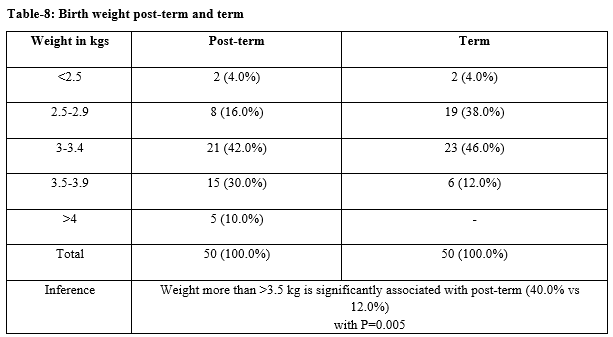A comparative study of the maternal, fetal and early neonatal outcome at term and post-term gestation
Abstract
Objectives: To study the maternal and fetal outcome and complications in post-term pregnancies and to compare them with an equal number of term pregnancies.
Materials and Methods: The study was conducted in the department of OBG, AIMS, B.G. Nagara. 50 cases of post-term singleton pregnancies with Gestational age > 42 weeks, 18-35 years of age with reliable dates and no obstetric or medical complications were the study group. The control group comprised of 50 singleton pregnancies between 37 and 42 weeks, 18-35 years of age with reliable dates and no obstetric or medical complications. The maternal morbidity was based on mode of delivery, operative interventions, injuries, PPH and Fetal morbidity was based on number of fetuses with meconium staining of amniotic fluid, NICU admissions, asphyxia, metabolic complications.
Results: Post-term pregnancy was found to be associated with increased morbidity, In the mother, labor had to be induced in a significant number of cases (p 0.070) since a large number of them had a low Bishop's score (p=0.086). Operative interference in the form of LSCS was positively associated with post-term (p=0.166) with causes varying from the failure of induction, prolonged labor. fetal distress, macrosomia and oligohydramnios (p <004). Perinatal morbidity was significantly associated with Post-term (32.0% vs 6.06) with P<0.001 due to birth asphyxia, meconium aspiration syndrome, the incidence of Meconium stained liquor being 60% (P-0.001).
Conclusion: The maternal and fetal morbidity is significantly increased after 42 weeks. There is a great need for accurate dating of pregnancy. The importance of induction of labor at 41 weeks and definitely not beyond 42 weeks cannot be sufficiently stressed.
Downloads
References
Usher RH, Boyd ME, McLean FH, Kramer MS. Assessment of fetal risk in postdate pregnancies. Am J Obstet Gynecol. 1988;158(2):259-264. doi: https://doi.org/10.1016/0002-9378(88)90134-2.
Rayburn W, Gosen R, Ramadei C, Woods R, Scott Jr J. Outpatient cervical ripening with prostaglandin E2 gel in uncomplicated postdate pregnancies. Am J Obstet Gynecol. 1988;158(6):1417-1423. doi: https://doi.org/10.1016/0002-9378(88)90376-6.
Divon MY, Haglund B, Nisell H, Otterblad PO, Westgren M. Fetal and neonatal mortality in the postterm pregnancy: the impact of gestational age and fetal growth restriction. Am J Obstet Gynecol. 1998;178(4):726-731. doi: https://doi.org/10.1016/s0002-9378(98)70482-x.
James DK, Steer PJ, Weiner CP, Gonik B, Robson SC, editors. High-risk pregnancy: management options. Cambridge University Press; 2017, 4th Ed, Saunders.
Zwerdling MA. Factors pertaining to prolonged pregnancy and its outcome. Pediatr. 1967;40(2):202-212.
Rayburn WF, Motley ME, Stempel LE, Gendreau RM. Antepartum prediction of the postmature infant. Obstet Gynecol. 1982;60(2):148-153.
Clement D, Schifrin BS, Kates RB. Acute oligohydramnios in postdate pregnancy. Am J Obstet Gynecol. 1987;157(4):884-886. doi: https://doi.org/10.1016/s0002-9378(87)80078-9.
National Institute of Child Health and Human Development Network of Maternal‐Fetal Medicine Units. A clinical trial of induction of labor versus expectant management in postterm pregnancy. Am J Obstet Gynecol. 1994;170(3):716-723. doi: https://doi.org/10.1016/S0002-9378(94)70269-1.
Bishnoi S, Bishnoi RK, Bora S. To Evaluate the Maternal & Fetal Complications and Outcomes in Post-Term Pregnancy: An Institutional Based Study. J Med Sci Clinic Res. 2018;6(6):650-655. https://dx.doi.org/10.18535/jmscr/v6i6.108.
Eden RD, Seifert LS, Winegar A, Spellacy WN. Perinatal characteristics of uncomplicated postdate pregnancies. Obstet Gynecol. 1987;69(3 Pt 1):296-299.
Vorherr H. Placental insufficiency and postmaturity. Eur J Obstet Gynecol Reprod Biol. 1975;5(1-2):109-122. doi: https://doi.org/10.1016/0028-2243(75)90136-7.
Alexander JM, McIntire DD, Leveno KJ. Forty weeks and beyond: pregnancy outcomes by week of gestation. Obstet Gynecol. 2000;96(2):291-294. doi: https://doi.org/10.1016/s0029-7844(00)00862-0.
Callenbach JC, Hall RT. Morbidity and mortality of advanced gestational age: post-term or postmature. Obstet Gynecol. 1979;53(6):721-724.
Phelan JP, Platt LD, Yeh SY, Trujillo MA, Paul RH. Continuing role of the nonstress test in the management of postdates pregnancy. Obstet Gynecol. 1984;64(5):624-628.
Pollack RN, Hauer-Pollack G, Divon MY. Macrosomia in postdates pregnancies: the accuracy of routine ultrasonographic screening. Am J Obstet Gynecol. 1992;167(1):7-11. doi: https://doi.org/10.1016/s0002-9378(11)91615-9.
Shime J, Gare DJ, Andrews J, Bertrand M, Salgado J, Whillans G. Prolonged pregnancy: surveillance of the fetus and the neonate and the course of labor and delivery. Am J Obstet Gynecol. 1984;148(5):547-552. doi: https://doi.org/10.1016/0002-9378(84)90745-2.
Harris JB, Huddleston JF, Sutliff GA, Perlis HW. The unfavorable cervix in prolonged pregnancy. Obstet Gynecol. 1983;62(2):171-174.
Boulvain M, Irion O, Marcoux S, Fraser W. Sweeping of the membranes to prevent post‐term pregnancy and to induce labour: a systematic review. BJOG: Int J Obstet Gynaecol. 1999;106(5):481-485. doi: https://doi.org/10.1111/j.1471-0528.1999.tb08302.x.
Hannah ME, Hannah WJ, Hellmann J, Hewson S, Milner R, Willan A. Canadian Multicenter Post-term Pregnancy Trial Group*. Induction of labor as compared with serial antenatal monitoring in post-term pregnancy: a randomized controlled trial. New Eng J Med. 1992;326(24):1587-1592. doi: https://doi.org/10.1056/NEJM199206113262402.
Rand L, Robinson JN, Economy KE, Norwitz ER. Post-term induction of labor revisited. Obstet Gynecol. 2000;96(5):779-783. doi: https://doi.org/10.1016/s0029-7844(00)01002-4.
Roberts LJ, Young KR. The management of prolonged pregnancy—an analysis of women's attitudes before and after term. BJOG: Int J Obstet Gynaecol. 1991;98(11):1102-1106. doi: https://doi.org/10.1111/j.1471-0528.1991.tb15361.x.

Copyright (c) 2020 Author (s). Published by Siddharth Health Research and Social Welfare Society

This work is licensed under a Creative Commons Attribution 4.0 International License.


 OAI - Open Archives Initiative
OAI - Open Archives Initiative



















 Therapoid
Therapoid

